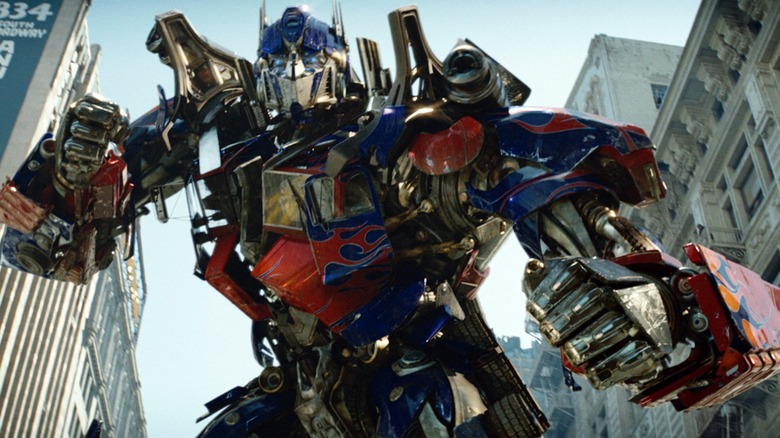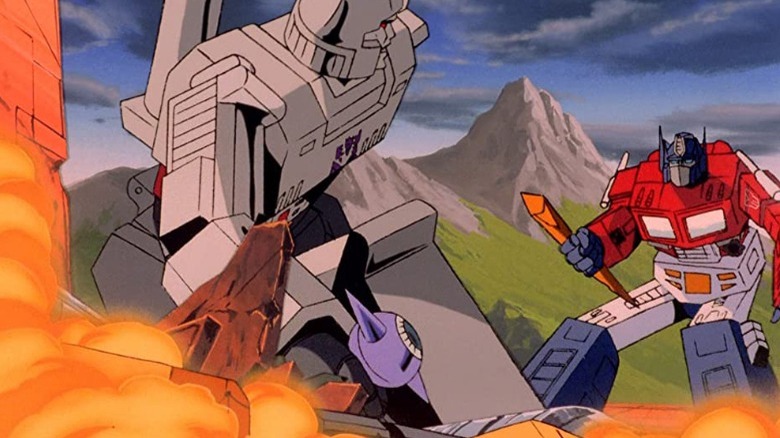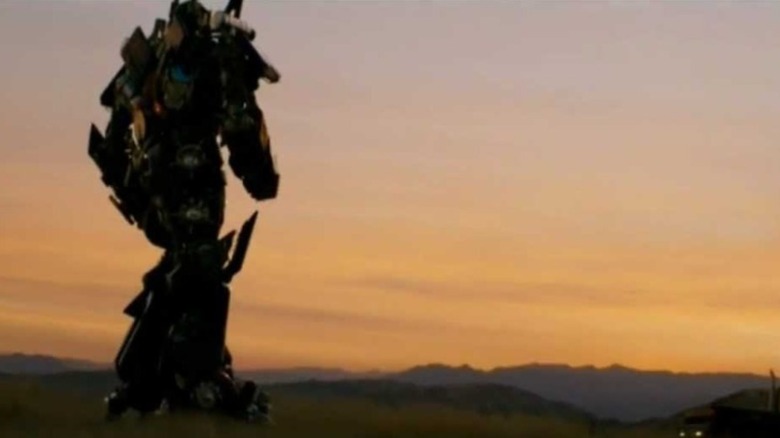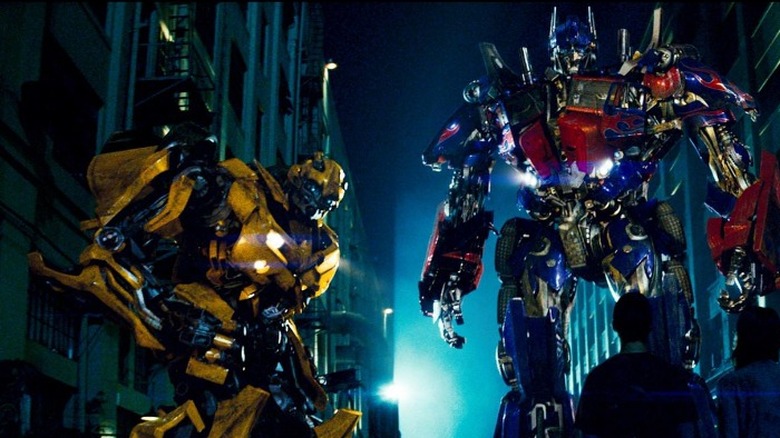How Steven Spielberg Talked Michael Bay Into Making Transformers
For good or for ill, Michael Bay's run of films in the "Transformers" series, from the first in 2007 to 2017's "Transformers: The Last Knight," defined that era of the blockbuster. He took the Hasbro toy line (and associated media) and blew it up to massive proportions, with each successive movie somehow expanding the scale even more. Excess was the word for the series — star-studded casts, huge explosions, some incredible action scenes, and the blinding orange-teal color grading that became inescapable in the late '00s, all suggested something that had little to do with the original "Transformers" media. Which shouldn't surprise anybody, given that Bay had little to no understanding of the material he was adapting.
To watch the first "Transformers" movie today, it's shocking how small-scale next to what the series would become. For all intents and purposes, it's got two major plot threads: an alien invasion (of giant robots) galvanizes the U.S. Military, and a teenage boy's purchase of an old car leading to him being responsible for the fate of the world. The story is simple enough, with broad, archetypal characters who make for a nice entry into the main event: giant robots fighting and destroying cities. Bay understood how to get there, but when the idea for the series was first pitched to him, he had no interest in it. And then a big director changed his mind.
Parallel ascents
Around the time the "Transformers" multimedia franchise began in earnest in 1984, Michael Bay had already broken into the film industry, filing storyboards for Lucasfilm — in particular, for Steven Spielberg's classic Indiana Jones debut "Raiders of the Lost Ark." He was just 15 years old then, skeptical of that movie's prospects, and ultimately so blown away by the final result that it steered him towards the directing profession. By the early '90s, Bay had picked up national esteem for his commercial and music video work, sought out by artists like Aerosmith and Meatloaf to design their visual identities, according to a 1998 article from Entertainment Weekly. There, Bay recalled, he was "suddenly being paid a lot of money to do work I really loved doing." Mega-producer Jerry Bruckheimer hired him shortly after, telling Variety that "it was easy to see how talented he was."
Meanwhile, "Transformers" exploded, becoming perhaps the definitive example of the '80s multimedia success. Toys and cartoons and comics and animated films (the first of which actually gave Orson Welles his final film role) carried the franchise across numerous avenues. The storyline developed by Marvel writers Jim Shooter and Dennis O'Neil was an easy draw for children, and the clear, bold designs of the Transformers (the good Autobots, the bad Decepticons) translated perfectly to Hasbro's toys.
Bay needed convincing
The "Transformers" franchise continued and expanded for decades while Michael Bay established his reputation in Hollywood. As a slick and cynical commercial filmmaker, he peppered his films with "what audiences want:" big explosions, larger-than-life plotlines, all of "Armageddon." This continued even in his more deceptively personal films, like the curiously grotesque "Bad Boys II."
He was accused of dumbing down American cinema. With Entertainment Weekly in 1998, he would discuss the possibility of changing up his style, saying, "if I could get through all these space-shuttle scripts I'm constantly being sent, I could do something really different." "Transformers" would not be different. It would feature everything for which he'd become known, in all of its Bay glory.
A phone call led to the job. Michael Bay's former "Raiders of the Lost Ark" boss Steven Spielberg had sought him out to discuss making "Transformers." He began his pitch by telling Bay that it was "about a boy who's getting his first car, and it turns into ... an alien." As Bay recalled to Collider, he told Spielberg "this was a bad idea" and hung up.
Still, Spielberg was insistent, and Bay felt a compulsion to meet with Hasbro officially. He had no real familiarity with "Transformers," having been a grown man in film school and commercial work during most of its airing. But he would be convinced.
The image maker
Spielberg would call Bay "a powerful and provocative image maker" in Variety. He clearly saw a connection between Bay and this series of giant robot fights that Bay himself couldn't, and wouldn't, until the day of the Hasbro meeting.
Walking into the Hasbro offices, Bay would recall to Collider the strangeness of seeing the original toys with which he grew up. Inspiration would emerge in the boardroom, with Bay learning the lore of the "Transformers" franchise while looking at the design of an anime robot. As a consummate Hollywood stylist, he began to think of just what a giant robot may look like in real life, the way light could reflect off of it as it moved. The gears turned, with one image, in particular, sparking his commitment:
"...what if a kid is trying to hide these robots that are 20-30 feet, behind his house, and his parents are inside... that was the movie. And then that's wish fulfillment ... can we make this lifelike?"
That became his focus, and he still speaks with pride about the VFX for the movie, far more than his 2022 film "Ambulance."
Despite being insecure about making a film for children, Bay approached the material with seriousness and realism, a mix that resulted in incredible box office returns and less-than-stellar reviews. After years on the franchise, he would eventually get told by Spielberg that he possibly made too many. But restraint was never Bay's strong suit.



